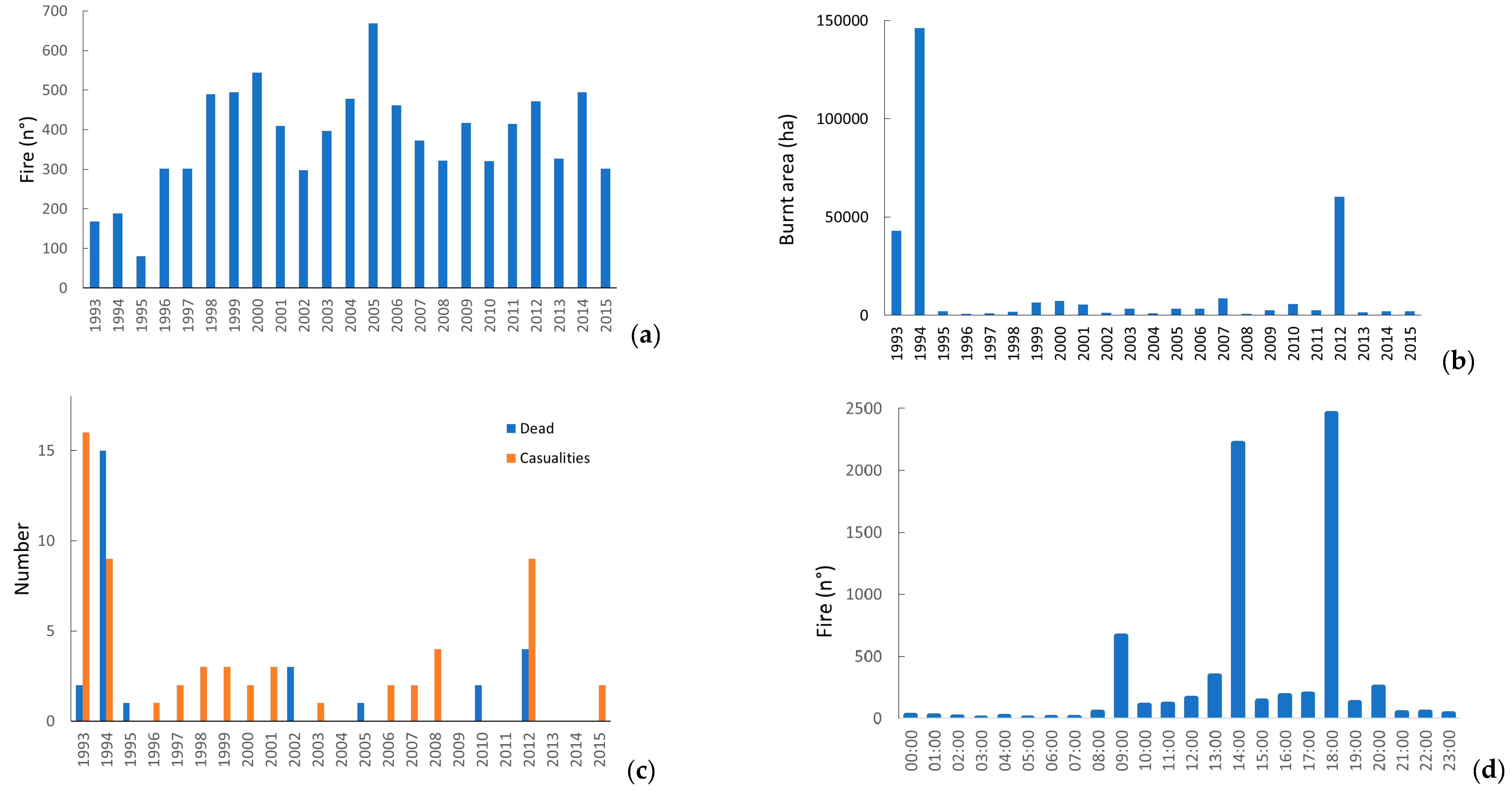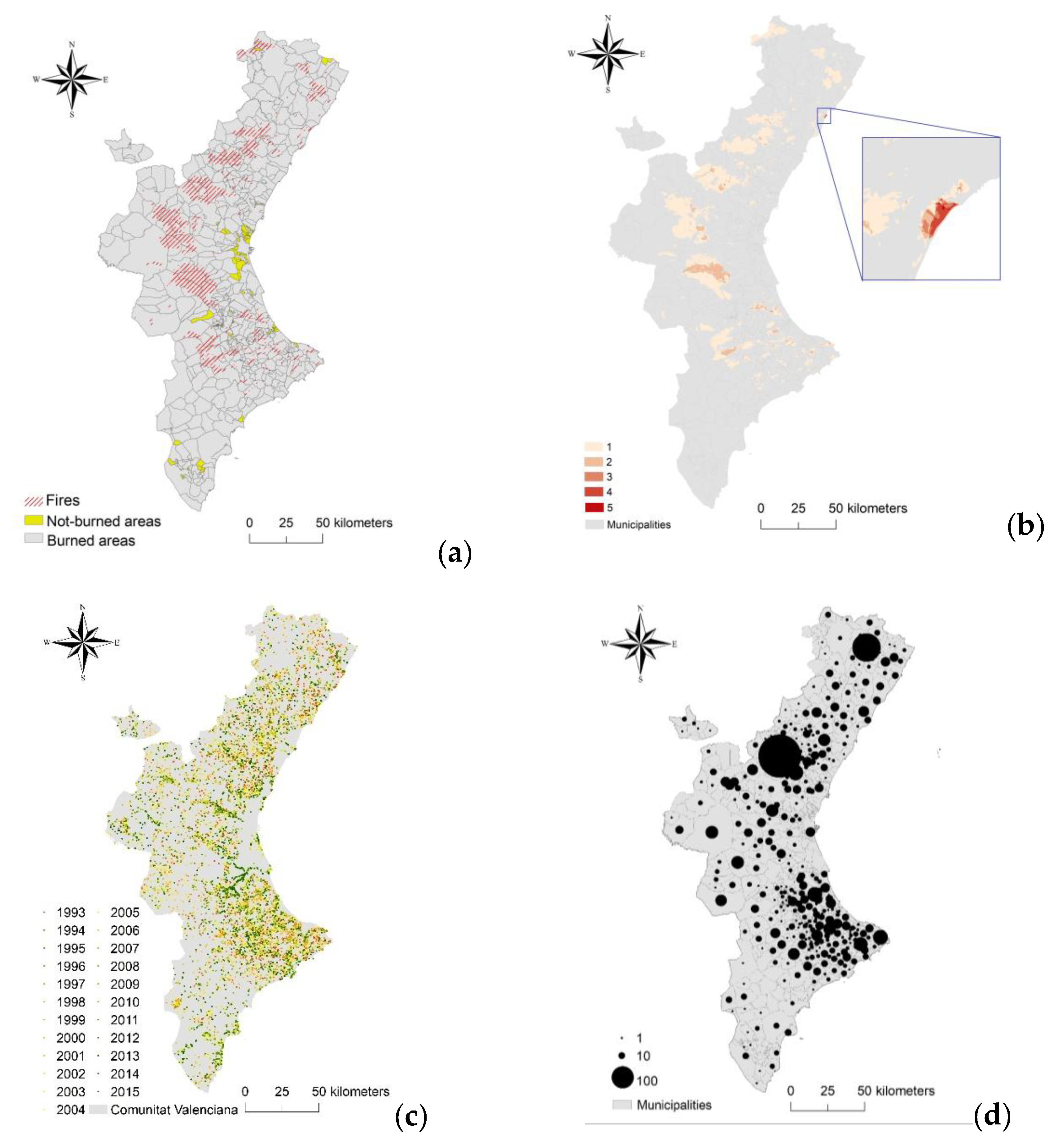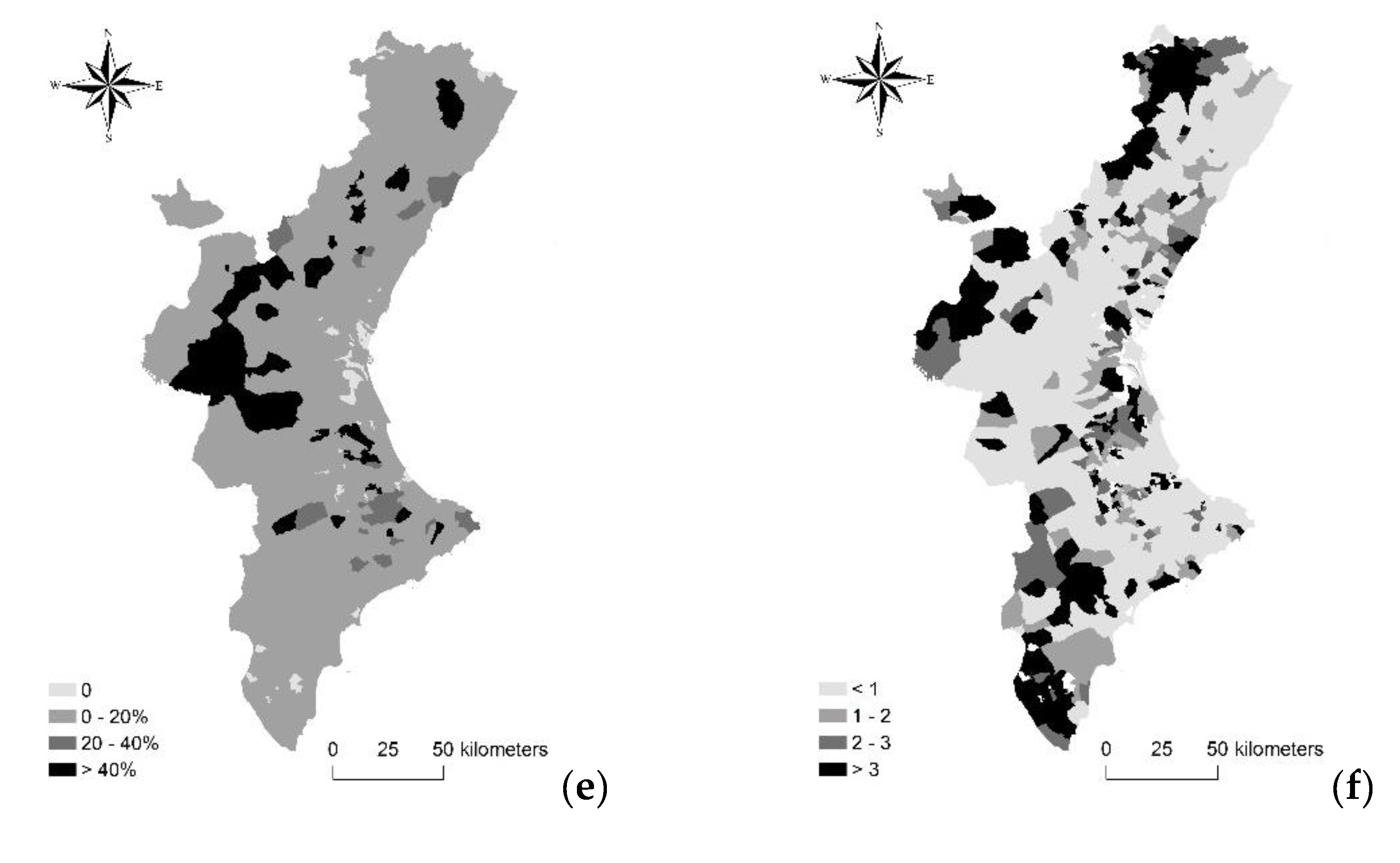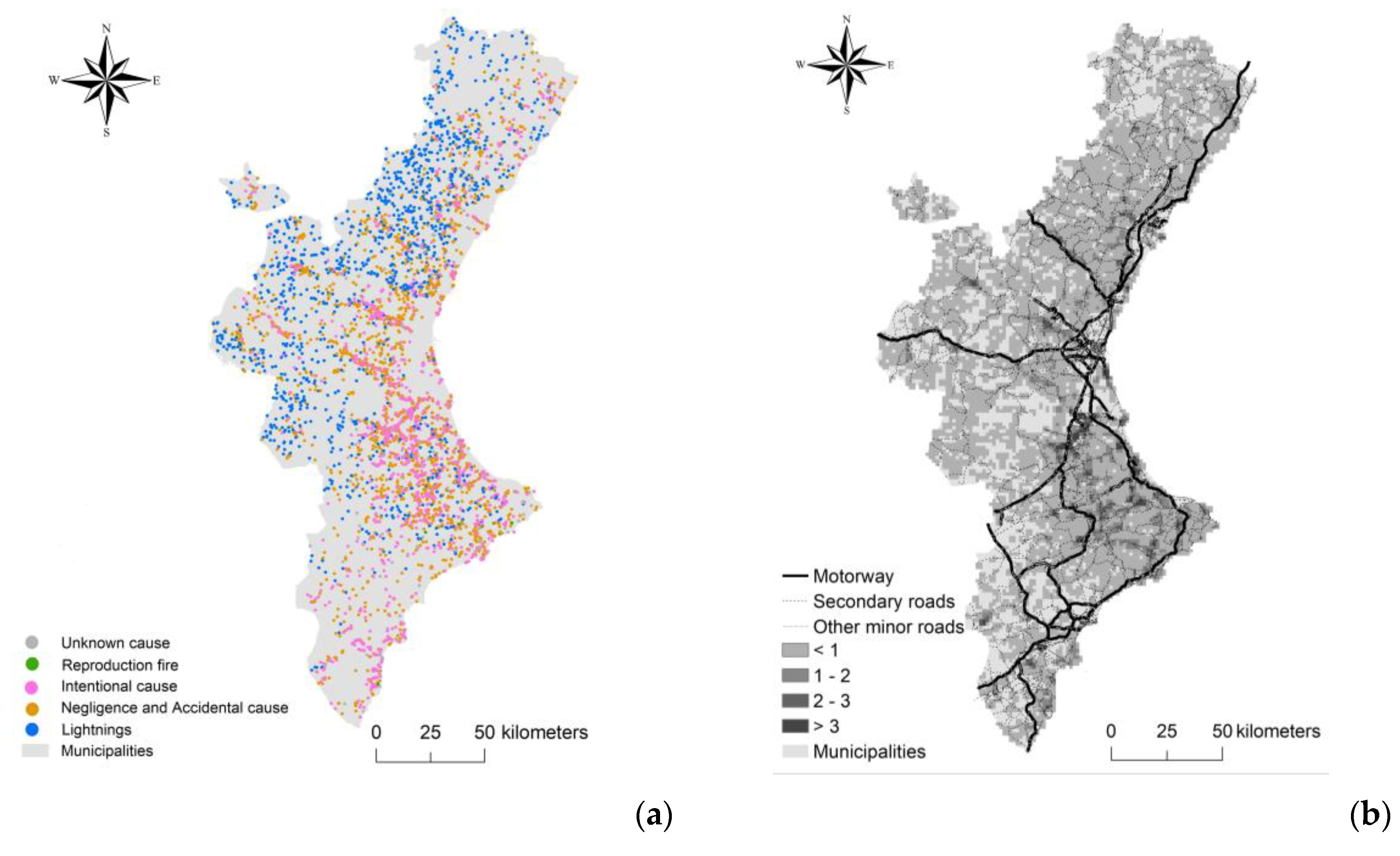Road Network and the Spatial Distribution of Wildfires in the Valencian Community (1993–2015)
Abstract
:1. Introduction
2. Methodology
2.1. Study Area
2.2. Analysis of Wildfire Distribution in the Valencian Community
2.3. Data Analysis
3. Results
4. Discussion
5. Conclusions
Author Contributions
Funding
Conflicts of Interest
References
- Collins, M.; Knutti, R.; Arblaster, J.; Dufresne, J.-L.; Fichefet, T.; Friedlingstein, P.; Gao, X.; Gutowski, W.J.; Johns, T.; Krinner, G.; et al. Long-term climate change: projections, commitments and irreversibility. In Climate Change 2013: The Physical Science Basis; Cambridge University Press: Cambridge, UK; New York, NY, USA, 2013. [Google Scholar]
- González-Gómez, M.; Álvarez-Díaz, M.; Otero-Giráldez, M.S. Estimating the long-run impact of forest fires on the eucalyptus timber supply in Galicia, Spain. J. Econ. 2013, 19, 149–161. [Google Scholar] [CrossRef] [Green Version]
- Irland, L.C. Extreme value analysis of forest fires from New York to Nova Scotia, 1950–2010. Ecol. Manag. 2013, 294, 150–157. [Google Scholar] [CrossRef]
- Tessler, N.; Wittenberg, L.; Provizor, E.; Greenbaum, N. The influence of short-interval recurrent forest fires on the abundance of Aleppo pine (Pinus halepensis Mill.) on Mount Carmel, Israel. Ecol. Manag. 2014, 324, 109–116. [Google Scholar] [CrossRef]
- Doerr, S.; Shakesby, R.; Walsh, R.; Doerr, S. Soil water repellency: Its causes, characteristics and hydro-geomorphological significance. Earth-Sci. Rev. 2000, 51, 33–65. [Google Scholar] [CrossRef]
- Cerdà, A. Changes in overland flow and infiltration after a rangeland fire in a Mediterranean scrubland. Hydrol. Process. 1998, 12, 1031–1042. [Google Scholar] [CrossRef]
- Mataix-Solera, J.; Cerdà, A.; Arcenegui, V.; Jordán, A.; Zavala, L.M.M. Fire effects on soil aggregation: A review. Earth-Sc. Rev. 2011, 109, 44–60. [Google Scholar] [CrossRef]
- Keesstra, S.; Wittenberg, L.; Maroulis, J.; Sambalino, F.; Malkinson, D.; Cerdà, A.; Pereira, P. The influence of fire history, plant species and post-fire management on soil water repellency in a Mediterranean catchment: The Mount Carmel range, Israel. Catena 2017, 149, 857–866. [Google Scholar] [CrossRef]
- Wittenberg, L.; Malkinson, D.; Beeri, O.; Halutzy, A.; Tesler, N. Spatial and temporal patterns of vegetation recovery following sequences of forest fires in a Mediterranean landscape, Mt. Carmel Israel. Catena 2010, 71, 76–83. [Google Scholar] [CrossRef]
- Cuadrado-Ciuraneta, S.; Durà-Guimerà, A.; Salvati, L. Not only tourism: unravelling suburbanization, second-home expansion and “rural” sprawl in Catalonia, Spain. Urban Geogr. 2017, 38, 66–89. [Google Scholar] [CrossRef]
- Choi, C.Y.; Lee, E.J.; Nam, H.Y.; Lee, W.S.; Lim, J.H. Temporal changes in the breeding bird community caused by post-fire treatments after the Samcheok forest fire in Korea. Landsc. Ecol. Eng. 2014, 10, 203–214. [Google Scholar] [CrossRef]
- Cossio, F.; Riccioni, S.; Zambon, I.; Mazzocchi, F.; Mosiello, M.; Monarca, D. Forest fires in Viterbo province and in Lazio region, in 1997-2012 period: Origin, frequency and incidence. Contemp. Eng. Sci. 2016, 9, 1305–1314. [Google Scholar] [CrossRef]
- Kelly, C.; Ferrara, A.; Wilson, G.A.; Ripullone, F.; Nolè, A.; Harmer, N.; Salvati, L. Community resilience and land degradation in forest and shrubland socio-ecological systems: Evidence from Gorgoglione, Basilicata, Italy. Land Use Policy 2015, 46, 11–20. [Google Scholar] [CrossRef] [Green Version]
- Pausas, J.G. Changes in Fire and Climate in the Eastern Iberian Peninsula (Mediterranean Basin). Clim. Chang. 2004, 63, 337–350. [Google Scholar] [CrossRef]
- Pereira, M.G.; Trigo, R.M.; Da Camara, C.C.; Pereira, J.M.; Leite, S.M.; Pereira, J.M.C. Synoptic patterns associated with large summer forest fires in Portugal. Agric. Meteorol. 2005, 129, 11–25. [Google Scholar] [CrossRef]
- Pausas, J.G.; Llovet, J.; Rodrigo, A.; Vallejo, R. Are wildfires a disaster in the Mediterranean basin? A review. Int. J. Wildland 2009, 17, 713–723. [Google Scholar] [CrossRef]
- Bajocco, S.; De Angelis, A.; Salvati, L. A satellite-based green index as a proxy for vegetation cover quality in a Mediterranean region. Ecol. Indic. 2012, 23, 578–587. [Google Scholar] [CrossRef]
- Poupkou, A.; Markakis, K.; Liora, N.; Giannaros, T.; Zanis, P.; Im, U.; Daskalakis, N.; Myriokefalitakis, S.; Kaiser, J.; Melas, D.; et al. A modeling study of the impact of the 2007 Greek forest fires on the gaseous pollutant levels in the Eastern Mediterranean. Atmos. Res. 2014, 149, 1–17. [Google Scholar] [CrossRef]
- Moreira, F.; Viedma, O.; Arianoutsou, M.; Curt, T.; Koutsias, N.; Rigolot, E.; Barbati, A.; Corona, P.; Vaz, P.; Xanthopoulos, G.; et al. Landscape – wildfire interactions in southern Europe: Implications for landscape management. J. Environ. Manag. 2011, 92, 2389–2402. [Google Scholar] [CrossRef] [Green Version]
- Viedma, O.; Urbieta, I.R.; Moreno, J.M. Wildfires and the role of their drivers are changing over time in a large rural area of west-central Spain. Sci. Rep. 2018, 8, 17797. [Google Scholar] [CrossRef]
- Russo, A.; Gouveia, C.M.; Páscoa, P.; Dacamara, C.C.; Sousa, P.M.; Trigo, R.M. Assessing the role of drought events on wildfires in the Iberian Peninsula. Agric. Meteorol. 2017, 237, 50–59. [Google Scholar] [CrossRef]
- Moreira, F.; Russo, D. Modelling the impact of agricultural abandonment and wildfires on vertebrate diversity in Mediterranean Europe. Landsc. Ecol. 2007, 22, 1461–1476. [Google Scholar] [CrossRef]
- Martínez-Sastre, R.; Ravera, F.; González, J.; Santiago, C.L.; Bidegain, I.; Munda, G. Mediterranean landscapes under change: Combining social multicriteria evaluation and the ecosystem services framework for land use planning. Land Use Policy 2017, 67, 472–486. [Google Scholar] [CrossRef]
- Sebastián-López, A.; Salvador-Civil, R.; Gonzalo-Jiménez, J.; San Miguel-Ayanz, J. Integration of socio-economic and environmental variables for modelling long-term fire danger in Southern Europe. Eur. J. For. Res. 2008, 127, 149–163. [Google Scholar] [CrossRef]
- Ganteaume, A.; Camia, A.; Jappiot, M.; San Miguel-Ayanz, J.; Long-Fournel, M. A review of the main driving factors of forest fire ignition over Europe. Environ. Manag. 2013, 51, 651–662. [Google Scholar] [CrossRef]
- Nunes, A.; Lourenço, L.; Meira, A.C.; Nunes, A. Exploring spatial patterns and drivers of forest fires in Portugal (1980–2014). Sci. Total Environ. 2016, 573, 1190–1202. [Google Scholar] [CrossRef] [PubMed]
- Moreira, F.; Vaz, P.; Catry, F.; Silva, J.S. Regional variations in wildfire preference for land cover types in Portugal: Implications for landscape management to minimize fire hazard. Int. J. Wildland Fire 2009, 18, 563–574. [Google Scholar] [CrossRef]
- Oliveira, S.; Oehler, F.; San-Miguel-Ayanz, J.; Camia, A.; Pereira, J.M.; Pereira, J.M.C. Modeling spatial patterns of fire occurrence in Mediterranean Europe using Multiple Regression and Random Forest. Ecol. Manag. 2012, 275, 117–129. [Google Scholar] [CrossRef]
- Oliveira, S.; Pereira, J.M.; San-Miguel-Ayanz, J.; Lourenço, L.; Pereira, J.M.C. Exploring the spatial patterns of fire density in Southern Europe using Geographically Weighted Regression. Appl. Geogr. 2014, 51, 143–157. [Google Scholar] [CrossRef]
- Cerdà, A.; Lasanta, T. Long-term erosional responses after fire in the Central Spanish Pyrenees: 1. Water and sediment yield. Catena 2005, 60, 59–80. [Google Scholar] [CrossRef]
- Rego, F.C.; Bunting, S.C.; Da Silva, J.M. Changes in understory vegetation following prescribed fire in maritime pine forests. Ecol. Manag. 1991, 41, 21–31. [Google Scholar] [CrossRef]
- Buscarino, A.; Frasca, M.; Gambuzza, L.V.; Hövel, P.; Hoevel, P. Chimera states in time-varying complex networks. Physical E 2015, 91, 022817. [Google Scholar] [CrossRef]
- Fuentes-Santos, I.; Marey-Pérez, M.F.; González-Manteiga, W. Forest fire spatial pattern analysis in Galicia (NW Spain). Environ. Manag. 2013, 128, 30–42. [Google Scholar] [CrossRef]
- Ruffault, J.; Mouillot, F. Contribution of human and biophysical factors to the spatial distribution of forest fire ignitions and large wildfires in a French Mediterranean region. Int. J. Wildland Fire 2017, 26, 498. [Google Scholar] [CrossRef] [Green Version]
- Yang, J.; Weisberg, P.J.; Dilts, T.E.; Loudermilk, E.L.; Scheller, R.M.; Stanton, A.; Skinner, C. Predicting wildfire occurrence distribution with spatial point process models and its uncertainty assessment: A case study in the Lake Tahoe Basin, USA. Int. J. Wildland Fire 2015, 24, 380–390. [Google Scholar] [CrossRef]
- Martin, P. Towards methods for investigating on wildland fire causes. EUFIRELAB. EVRI-CT-2002-40028. Deliverable 0-05-02. 2004. Available online: http://www. eufirelab. org/prive/directory/units_section_5/D-05-03/D-05-03.pdf (accessed on 3 May 2019).
- Joint Research Centre (JRC). Forest Fires in Europe 2008; Report No 9, EUR 23971 EN; Publications Office of the European Union (OPOCE): Luxembourg, 2009. [Google Scholar]
- Slezakova, K.; Morais, S.; Pereira, M.D.C. Forest fires in Northern region of Portugal: Impact on PM levels. Atmos. Res. 2013, 127, 148–153. [Google Scholar] [CrossRef] [Green Version]
- Barbati, A.; Corona, P.; Salvati, L.; Gasparella, L. Natural forest expansion into suburban countryside: Gained ground for a green infrastructure? Urban For. Urban Green. 2013, 12, 36–43. [Google Scholar] [Green Version]
- Salvati, L. Agro-forest landscape and the ‘fringe’ city: A multivariate assessment of land-use changes in a sprawling region and implications for planning. Sci. Total Environ. 2014, 490, 715–723. [Google Scholar] [CrossRef] [PubMed]
- San-Miguel-Ayanz, J.; Moreno, J.M.; Camia, A. Analysis of large fires in European Mediterranean landscapes: Lessons learned and perspectives. Ecol. Manag. 2013, 294, 11–22. [Google Scholar] [CrossRef]
- Rodrigues, M.; Jiménez-Ruano, A.; Peña-Angulo, D.; de la Riva, J. A comprehensive spatial-temporal analysis of driving factors of human-caused wildfires in Spain using geographically weighted logistic regression. J. Environ. Manag. 2018, 225, 177–192. [Google Scholar] [CrossRef]
- San-Miguel-Ayanz, J.; Rodrigues, M.; de Oliveira, S.S.; Pacheco, C.K.; Moreira, F.; Duguy, B.; Camia, A. Land cover change and fire regime in the European Mediterranean region. In Post-Fire Management and Restoration of Southern European Forests; Springer: Dordrecht, The Netherlands, 2012; pp. 21–43. [Google Scholar]
- Colantoni, A.; Grigoriadis, E.; Sateriano, A.; Venanzoni, G.; Salvati, L. Cities as selective land predators? A Lesson on Urban Growth, (Un)effective planning and Sprawl Containment. Sci. Total Environ. 2016, 545–546, 329–339. [Google Scholar] [CrossRef]
- Martinez, J.; Chuvieco, E. Tipologias de incidencia y causalidad de incendios forestales basadas en am’llisis multivariante. Ecologia 2003, 17, 47–63. [Google Scholar]
- Vazquez, A.; Moreno, J. Patterns of Lightning-, and People-Caused Fires in Peninsular Spain. Int. J. Wildland Fire 1998, 8, 103. [Google Scholar] [CrossRef]
- Amatulli, G.; Pérez-Cabello, F.; De La Riva, J. Mapping lightning/human-caused wildfires occurrence under ignition point location uncertainty. Ecol. Model. 2007, 200, 321–333. [Google Scholar] [CrossRef]
- Benavent-Corai, J.; Rojo, C.; Suárez-Torres, J.; Velasco-García, L. Scaling properties in forest fire sequences: The human role in the order of nature. Ecol. Model. 2007, 205, 336–342. [Google Scholar] [CrossRef]
- Colantoni, A.; Mavrakis, A.; Sorgi, T.; Salvati, L. Towards a ’polycentric’ landscape? Reconnecting fragments into an integrated network of coastal forests in Rome. Rendiconti Accademia Nazionale dei Lincei 2015, 26, 615–624. [Google Scholar] [CrossRef]
- Salvati, L.; Zitti, M. Regional convergence of environmental variables: Empirical evidences from land degradation. Ecol. Econ. 2008, 68, 162–168. [Google Scholar] [CrossRef]
- Salvati, L.; Perini, L.; Sabbi, A.; Bajocco, S. Climate Aridity and Land Use Changes: A Regional-Scale Analysis. Geogr. Res. 2012, 50, 193–203. [Google Scholar] [CrossRef]
- Salvati, L.; Zitti, M.; Perini, L. Fifty years on: Long-term patterns of land sensitivity to desertification in Italy. Land. Degrad. Dev. 2016, 27, 97–107. [Google Scholar] [CrossRef]
- De Paz, J.-M.; Sánchez, J.; Visconti, F. Combined use of GIS and environmental indicators for assessment of chemical, physical and biological soil degradation in a Spanish Mediterranean region. J. Environ. Manag. 2006, 79, 150–162. [Google Scholar] [CrossRef]
- Malak, D.A.; Pausas, J.G.; Pardo-Pascual, J.E.; Ruiz, L.A. Fire Recurrence and the Dynamics of the Enhanced Vegetation Index in a Mediterranean Ecosystem. In Geospatial Intelligence; IGI Global: Hershey, PA, USA, 2019; pp. 1690–1708. [Google Scholar]
- Pausas, J.; Ribeiro, E.; Vallejo, R. Post-fire regeneration variability of Pinus halepensis in the eastern Iberian Peninsula. Ecol. Manag. 2004, 203, 251–259. [Google Scholar] [CrossRef]
- Pausas, J.G.; Bradstock, R.A.; Keith, D.A.; Keeley, J.E. Plant functional traits in relation to fire in crown-fire ecosystems. Ecology 2004, 85, 1085–1100. [Google Scholar] [CrossRef]
- Biasi, R.; Colantoni, A.; Ferrara, C.; Ranalli, F.; Salvati, L. In-between Sprawl and Fires: long-term Forest Expansion and Settlement Dynamics at the Wildland-Urban Interface in Rome, Italy. Int. J. Sustain. Dev. World Ecol. 2105, 22, 467–475. [Google Scholar] [CrossRef]
- Duvernoy, I.; Zambon, I.; Sateriano, A.; Salvati, L. Pictures from the other side of the fringe: Urban growth and peri-urban agriculture in a post-industrial city (Toulouse, France). J. Stud. 2018, 57, 25–35. [Google Scholar] [CrossRef]
- Keeley, J.E. Reexamining Fire Suppression Impacts on Brushland Fire Regimes. Science 1999, 284, 1829–1832. [Google Scholar] [CrossRef] [PubMed] [Green Version]
- Badía, A.; Serra, P.; Modugno, S. Identifying dynamics of fire ignition probabilities in two representative Mediterranean wildland-urban interface areas. Appl. Geogr. 2011, 31, 930–940. [Google Scholar] [CrossRef]
- Guyette, R.P.; Muzika, R.M.; Dey, D.C. Dynamics of an anthropogenic fire regime. Ecosystems 2002, 5, 472–486. [Google Scholar]
- Sibold, J.S.; Veblen, T.T.; Gonzalez, M.E. Spatial and temporal variation in historic fire regimes in subalpine forests across the Colorado Front Range in Rocky Mountain National Park, Colorado, USA. J. Biogeogr. 2006, 33, 631–647. [Google Scholar] [CrossRef]
- Syphard, A.D.; Radeloff, V.C.; Keuler, N.S.; Taylor, R.S.; Hawbaker, T.J.; Stewart, S.I.; Clayton, M.K. Predicting spatial patterns of fire on a southern California landscape. Int. J. Wildland Fire 2008, 17, 602–613. [Google Scholar] [CrossRef]
- Miranda, B.R.; Gustafson, E.J.; Yang, J.; He, H.S.; Sturtevant, B.R. Comparing effects of fire modeling methods on simulated fire patterns and succession: A case study in the Missouri Ozarks. Can. J. 2008, 38, 1290–1302. [Google Scholar]
- Kernan, J.T.; Hessl, A.E. Spatially Heterogeneous Estimates of Fire Frequency in Ponderosa Pine Forests of Washington, USA. Fire Ecol. 2010, 6, 117–135. [Google Scholar] [CrossRef]
- Arienti, M.C.; Cumming, S.G.; Krawchuk, M.A.; Boutin, S. Road network density correlated with increased lightning fire incidence in the Canadian western boreal forest. Int. J. Wildland Fire 2009, 18, 970–982. [Google Scholar] [CrossRef]
- Brosofske, K.D.; Cleland, D.T.; Saunders, S.C. Factors influencing modern wildfire occurrence in the Mark Twain National Forest, Missouri. South. J. Appl. For. 2007, 31, 73–84. [Google Scholar]
- Maingi, J.K.; Henry, M.C. Factors influencing wildfire occurrence and distribution in eastern Kentucky, USA. Int. J. Wildland Fire 2007, 16, 23–33. [Google Scholar] [CrossRef]
- Syphard, A.D.; Radeloff, V.C.; Keeley, J.E.; Hawbaker, T.J.; Clayton, M.K.; Stewart, S.I.; Hammer, R.B. HUMAN INFLUENCE ON CALIFORNIA FIRE REGIMES. Ecol. Appl. 2007, 17, 1388–1402. [Google Scholar] [CrossRef] [PubMed]
- Yang, J.; He, H.S.; Shifley, S.R.; Gustafson, E.J. Spatial patterns of modern period human-caused fire occurrence in the Missouri Ozark Highlands. For. Sci. 2007, 53, 1–15. [Google Scholar]
- Caballero, D.; Beltrán, I.; Velasco, A. Forest fires and wildland-urban interface in Spain: Types and risk distribution. In Proceedings of the 4th International Wildland Fire Conference (IV Conferencia Internacional sobre Incendios Forestales), Sevilla, Spain, 14–17 May 2007. [Google Scholar]
- Jaiswal, R.K.; Mukherjee, S.; Raju, K.D.; Saxena, R. Forest fire risk zone mapping from satellite imagery and GIS. Int. J. Appl. Earth Obs. Geoinf. 2002, 4, 1–10. [Google Scholar] [CrossRef]
- Alencar, A.; Asner, G.P.; Knapp, D.; Zarin, D. Temporal variability of forest fires in eastern Amazonia. Ecol. Appl. 2010, 21, 2397–2412. [Google Scholar] [CrossRef]
- Artés, T.; Cardil, A.; Cortes, A.; Margalef, T.; Molina, D.; Pelegrín, L.; Ramírez, J. Forest Fire Propagation Prediction Based on Overlapping DDDAS Forecasts. Procedia Comput. Sci. 2015, 51, 1623–1632. [Google Scholar] [CrossRef] [Green Version]
- Pili, S.; Grigoriadis, E.; Carlucci, M.; Clemente, M.; Salvati, L. Towards sustainable growth? A multi-criteria assessment of (changing) urban forms. Ecol. Indic. 2017, 76, 71–80. [Google Scholar] [CrossRef]
- Lampin-Maillet, C.; Jappiot, M.; Long, M.; Bouillon, C.; Morge, D.; Ferrier, J.-P. Mapping wildland-urban interfaces at large scales integrating housing density and vegetation aggregation for fire prevention in the South of France. J. Environ. Manag. 2010, 91, 732–741. [Google Scholar] [CrossRef] [Green Version]
- Zheng, S.; Li, C.; Su, X.; Qiu, Q.; Shao, G. Risk assessment for effective prevention and management of forest fires in Lijiang City. Int. J. Sustain. Dev. World Ecol. 2011, 18, 509–514. [Google Scholar] [CrossRef]
- Zitti, M.; Ferrara, C.; Perini, L.; Carlucci, M.; Salvati, L. Long-term Urban Growth and Land-use Efficiency in Southern Europe: Implications for Sustainable Land Management. Sustainability 2015, 7, 3359–3385. [Google Scholar] [CrossRef]
- Zambon, I.; Colantoni, A.; Cecchini, M.; Mosconi, E.M. Rethinking Sustainability within the Viticulture Realities Integrating Economy, Landscape and Energy. Sustainability 2018, 10, 320. [Google Scholar] [CrossRef]
- Heyerdahl, E.K.; Brubaker, L.B.; Agee, J.K. Spatial Controls of Historical Fire Regimes: A Multiscale Example from the Interior West, USA. Ecology 2001, 82, 660–678. [Google Scholar] [CrossRef]
- Boubaker, K.; Colantoni, A.; Marucci, A.; Longo, L.; Gambella, F.; Cividino, S.; Gallucci, F.; Monarca, D.; Cecchini, M. Perspective and potential of CO2: A focus on potentials for renewable energy conversion in the Mediterranean basin. Renew. Energy 2016, 90, 248–256. [Google Scholar] [CrossRef]
- Darques, R. Mediterranean cities under fire. A critical approach to the wildland–urban interface. Appl. Geogr. 2015, 59, 10–21. [Google Scholar] [CrossRef]
- Fernandes, P.M.; Davies, G.M.; Ascoli, D.; Fernández, C.; Moreira, F.; Rigolot, E.; Stoof, C.R.; Vega, J.A.; Molina, D. Prescribed burning in southern Europe: Developing fire management in a dynamic landscape. Front. Ecol. 2013, 11, 4. [Google Scholar] [CrossRef]
- Kalabokidis, K.; Athanasis, N.; Gagliardi, F.; Karayiannis, F.; Palaiologou, P.; Parastatidis, S.; Vasilakos, C. Virtual Fire: A web-based GIS platform for forest fire control. Ecol. Inf. 2013, 16, 62–69. [Google Scholar] [CrossRef]
- San-Miguel-Ayanz, J.; Schulte, E.; Schmuck, G.; Camia, A. The European Forest Fire Information System in the context of environmental policies of the European Union. For. Econ. 2013, 29, 19–25. [Google Scholar] [CrossRef]
- Herrero-Corral, G.; Jappiot, M.; Bouillon, C.; Long-Fournel, M. Application of a geographical assessment method for the characterization of wildland–urban interfaces in the context of wildfire prevention: A case study in western Madrid. Appl. Geogr. 2012, 35, 60–70. [Google Scholar] [CrossRef]
- Lein, J.K.; Stump, N.I. Assessing wildfire potential within the wildland–urban interface: A southeastern Ohio example. Appl. Geogr. 2009, 29, 21–34. [Google Scholar] [CrossRef]
- Salvati, L.; Zitti, M.; Ceccarelli, T. Integrating economic and environmental indicators in the assessment of desertification risk: A case study. Appl. Ecol. Environ. Res. 2008, 6, 129–138. [Google Scholar] [CrossRef]
- Whitman, E.; Rapaport, E.; Sherren, K. Modeling Fire Susceptibility to Delineate Wildland–Urban Interface for Municipal-Scale Fire Risk Management. Environ. Manag. 2013, 52, 1427–1439. [Google Scholar] [CrossRef]
- Catalán, B.; Saurí, D.; Serra, P. Urban sprawl in the Mediterranean? Patterns of growth and change in the Barcelona Metropolitan Region 1993–2000. Landsc. Urban Plan 2008, 85, 174–184. [Google Scholar] [CrossRef]
- Ferrara, C.; Moretti, V.; Serra, P.; Salvati, L. Towards a sustainable agro-forest landscape? assessing land degradation (1950–2010) and soil quality in Castelporziano forest and peri-urban Rome, Italy. Rendiconti Lincei 2015, 26, 597–604. [Google Scholar] [CrossRef]
- Ranalli, F.; Salvati, L. Complex Patterns, Unpredictable Consequences: The Distribution of Sealed Land along the Urban-rural Gradient in Barcelona. dag 2015, 61, 393. [Google Scholar] [CrossRef] [Green Version]
- Novara, A.; Pulido, M.; Rodrigo-Comino, J.; Di Prima, S.; Smith, P.; Gristina, L.; Gimenez-Morera, A.; Terol, E.; Salesa, D.; Keesstra, S. Long-term organic farming on a citrus plantation results in soil organic carbon recovery. Cuadernos de Investigación Geográfica 2019. [Google Scholar] [CrossRef]
- Rodrigo-Comino, J.; Senciales, J.M.; Cerdà, A.; Brevik, E.C. The multidisciplinary origin of soil geography: A review. Earth-Sci. Rev. 2018, 177, 114–123. [Google Scholar] [CrossRef]
- Antoneli, V.; Rebinski, E.A.; Bednarz, J.A.; Rodrigo-Comino, J.; Keesstra, S.D.; Cerda, A.; Fernández, M.P. Soil Erosion Induced by the Introduction of New Pasture Species in a Faxinal Farm of Southern Brazil. Geosciences 2018, 8, 166. [Google Scholar] [CrossRef]
- Cerdà, A.; Borja, M.E.L.; Úbeda, X.; Martínez-Murillo, J.F.; Keesstra, S. Pinus halepensis M. versus Quercus ilex subsp. Rotundifolia L. runoff and soil erosion at pedon scale under natural rainfall in Eastern Spain three decades after a forest fire. For. Ecol. Manag. 2017, 400, 447–456. [Google Scholar] [CrossRef] [Green Version]
- Van Eck, C.M.; Nunes, J.P.; Vieira, D.C.; Keesstra, S.; Keizer, J.J. Physically-Based Modelling of the Post-Fire Runoff Response of a Forest Catchment in Central Portugal: Using Field versus Remote Sensing Based Estimates of Vegetation Recovery. Land Degrad. Dev. 2016, 27, 1535–1544. [Google Scholar] [CrossRef]
- Nunes, J.P.; Naranjo Quintanilla, P.; Santos, J.M.; Serpa, D.; Carvalho-Santos, C.; Rocha, J.; Keesstra, S.D. Afforestation, subsequent forest fires and provision of hydrological services: A model-based analysis for a Mediterranean mountainous catchment. Land Degrad. Dev. 2018, 29, 776–788. [Google Scholar] [CrossRef]
- Di Prima, S.; Lassabatere, L.; Rodrigo-Comino, J.; Marrosu, R.; Pulido, M.; Angulo-Jaramillo, R.; Úbeda, X.; Keesstra, S.; Cerda, A.; Pirastru, M. Comparing Transient and Steady-State Analysis of Single-Ring Infiltrometer Data for an Abandoned Field Affected by Fire in Eastern Spain. Water 2018, 10, 514. [Google Scholar] [CrossRef]
- Plaza-Álvarez, P.; Lucas-Borja, M.; Sagra, J.; Zema, D.; González-Romero, J.; Moya, D.; Heras, J.D.L. Changes in soil hydraulic conductivity after prescribed fires in Mediterranean pine forests. J. Environ. Manag. 2019, 232, 1021–1027. [Google Scholar] [CrossRef]
- Lucas-Borja, M.E.; Zema, D.A.; Carrà, B.G.; Cerdà, A.; Plaza-Alvarez, P.A.; Cózar, J.S.; Gonzalez-Romero, J.; Moya, D.; Heras, J.D.L. Short-term changes in infiltration between straw mulched and non-mulched soils after wildfire in Mediterranean forest ecosystems. Ecol. Eng. 2018, 122, 27–31. [Google Scholar] [CrossRef]
- Keesstra, S.; Mol, G.; De Leeuw, J.; Okx, J.; Molenaar, C.; De Cleen, M.; Visser, S. Soil-Related Sustainable Development Goals: Four Concepts to Make Land Degradation Neutrality and Restoration Work. Land 2018, 7, 133. [Google Scholar] [CrossRef]






| Road Type | Percentage Share in Total Length of Road Affected by Wildfires | Average | |||||
|---|---|---|---|---|---|---|---|
| Unknown | Reproduction Fire | Intentional | Negligence Accidental | Lightning | Total | Fire Size (ha) | |
| 0.1 km buffer | |||||||
| Highway | 8.4 | 26.8 | 9.0 | 14.3 | 5.3 | 11.3 | 1.2 |
| Basic | 15.5 | 6.4 | 10.4 | 12.7 | 8.3 | 11.5 | 0.3 |
| Local | 52.9 | 57.5 | 46.0 | 44.3 | 55.0 | 46.5 | 23.3 |
| Municipal | 16.5 | 0.0 | 25.3 | 20.4 | 27.3 | 22.5 | 1.9 |
| Collecting way | 0.0 | 0.0 | 0.3 | 0.0 | 0.0 | 0.1 | 0 |
| Auxiliary branches | 5.1 | 2.2 | 4.4 | 4.6 | 1.4 | 4.2 | 0.2 |
| Service road | 1.6 | 7.1 | 4.6 | 3.7 | 2.6 | 3.9 | 1.8 |
| Under construction | 0.0 | 0.0 | 0.0 | 0.0 | 0.0 | 0.0 | 0 |
| 0.5 km buffer | |||||||
| Highway | 10.8 | 20.0 | 13.3 | 15.7 | 8.6 | 13.9 | 1.5 |
| Basic | 13.0 | 11.7 | 11.7 | 12.3 | 9.8 | 11.9 | 0.9 |
| Local | 41.3 | 56.0 | 39.9 | 39.3 | 51.4 | 41.0 | 7.1 |
| Municipal | 22.3 | 8.7 | 22.0 | 20.9 | 21.3 | 21.3 | 0.8 |
| Collecting way | 0.3 | 0.0 | 0.3 | 0.1 | 0.0 | 0.2 | 0.2 |
| Auxiliary branches | 10.1 | 0.7 | 7.8 | 6.5 | 5.5 | 7.0 | 0.6 |
| Service road | 2.0 | 2.8 | 5.0 | 5.1 | 3.3 | 4.7 | 2.5 |
| Under construction | 0.0 | 0.0 | 0.0 | 0.0 | 0.0 | 0.0 | 0.2 |
© 2019 by the authors. Licensee MDPI, Basel, Switzerland. This article is an open access article distributed under the terms and conditions of the Creative Commons Attribution (CC BY) license (http://creativecommons.org/licenses/by/4.0/).
Share and Cite
Zambon, I.; Cerdà, A.; Cudlin, P.; Serra, P.; Pili, S.; Salvati, L. Road Network and the Spatial Distribution of Wildfires in the Valencian Community (1993–2015). Agriculture 2019, 9, 100. https://0-doi-org.brum.beds.ac.uk/10.3390/agriculture9050100
Zambon I, Cerdà A, Cudlin P, Serra P, Pili S, Salvati L. Road Network and the Spatial Distribution of Wildfires in the Valencian Community (1993–2015). Agriculture. 2019; 9(5):100. https://0-doi-org.brum.beds.ac.uk/10.3390/agriculture9050100
Chicago/Turabian StyleZambon, Ilaria, Artemi Cerdà, Pavel Cudlin, Pere Serra, Silvia Pili, and Luca Salvati. 2019. "Road Network and the Spatial Distribution of Wildfires in the Valencian Community (1993–2015)" Agriculture 9, no. 5: 100. https://0-doi-org.brum.beds.ac.uk/10.3390/agriculture9050100







